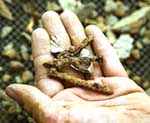The following is the second of two stories about
a Stamford Historical Society's archaeological dig at the Hoyt-Barnum House,
courtesy The Advocate:
August 17, 2002
The dig days of summer come to a close
at Hoyt Barnum House
By Alison Damast
Advocate Staff Writer
STAMFORD - Al Rechia's heartbeat quickened when he
saw the heel of a shoe poking out of the soil during the third and final day
of the archeological dig at Hoyt Barnum House.
"It's going to be a shoe from the Pilgrims,
I can just feel it," Rechia recalled thinking as he dug the shoe out with
his trowel.
But Rechia soon discovered that the dusty shoe, a
brown moccasin, never graced the foot of Samuel Hoyt, the blacksmith and farmer
who built the house in 1699. The house at 713 Bedford St. stands on its original
foundation.
It most likely was left behind purposely by amateur
archeologists who did a rough excavation of the same area in the early 1960s,
Stamford Historical Society Director Tom Zoubek said after glancing at the shoe.
"Archeologists often like to leave behind some
marker or evidence proving that they've been there," Zoubek said, pointing
out that a 1967 Fritos bag they found Monday probably was left behind for similar
reasons.
The shoe was one of the more unusual discoveries
of the morning. Zoubek, who holds a doctorate degree in archeology from Yale,
and two other volunteers - Rechia, an accountant from Milford, and Brook Caldwell,
a security worker from Stratford - sifted through the last of the 3 1/2 meters
of earth they had dug.
Fish and chicken bones, shards of clay, pipe stem
fragments and large quantities of shells were among the items Zoubek and his
team found in the former midden, the area outside the kitchen where residents
used to throw bones and household trash.
Some discoveries, such as a brass button and a mother
of pearl button, gave Zoubek new historical insight into the lives of the residents
of the house.
"I was surprised to see that," he said.
"This shows that some people had nice garments in those days."
The items found this week will be combined with the
artifacts from the dig that took place more than 30 years ago. The first dig
unearthed pottery dating to the 1700s, including pearlware, whiteware, creamware
and stoneware ceramic material.
The real work comes after the digging, Zoubek said.
"It's not just digging and finding," he
said. "If you just dig up material and don't analyze it, you haven't advanced
anything in history."
He hopes to place period plantings and an herb garden
in the former midden area at Hoyt Barnum House.
Zoubek is planning school trips this fall to the
house, where schoolchildren will be able to see some of the artifacts from the
dig, such as hand-forged nails found earlier this week.
Digs are planned for next spring and summer in areas
of the house such as the privy, the former outhouse where garbage also was tossed.
It's an area
that Zoubek calls a virtual "time
capsule."
But for now, he is content to put the dirt back and
take a break. Working in 90-degree weather for three days has not been easy.
"It's been miserable," he said. "We've
been digging in the hottest days of the summer."
Copyright © 2002, The Advocate
Reprinted with permission
 First
article on the subject, August 13, 2002
First
article on the subject, August 13, 2002
The Hoyt Barnum House


 First
article on the subject, August 13, 2002
First
article on the subject, August 13, 2002